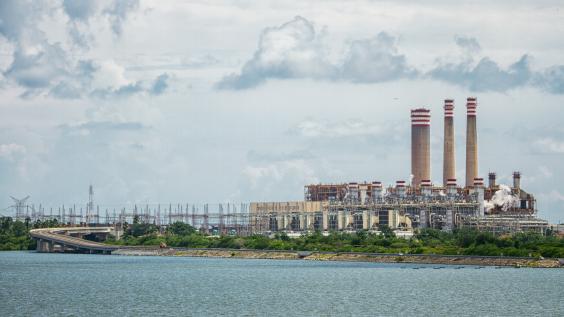Low Oil Prices Mean Trouble for Mexican Government's Finances

Table of Contents
Author(s)
Tony Payan
Françoise and Edward Djerejian Fellow for Mexico Studies | Director, Center for the U.S. and MexicoBy Tony Payan and Miguel Guevara
The 2014-2015 slump in oil prices punished, once again, economies that rely on commodities exports. That is hardly new. Commodity downturns can trigger capital flights, bringing about currency collapses. They also punish government budgets, forcing leaders to cut back on spending, run budget deficits or borrow more. The more dependent an economy is on commodities, the worse off it can be in such troughs. The recent oil price collapse did just that. Venezuela, for example, is on the verge of social upheaval as the government fails to deliver on its promises and balance its bills. In the midst of this, the Mexican case seems to an outlier since it has fared better than most.
Mexico may indeed fare better, and if the country’s leaders make an effort, Mexico will emerge in better shape than most, especially now that oil prices appear to be rebounding. But if they tinker with the solid macroeconomic foundations of the last three administrations for too long, the country may be headed for trouble.
On the positive side, while Mexico can well be considered an oil-dependent country, its circumstances are clearly different than those of most of Latin America. Of all the Latin American economies, it is the only one where manufacturing exports far surpass commodity exports. Oil revenues were only 6.1 percent of its GDP in 2013 and make up even less today. Agriculture represents a mere 3.5 percent of GDP. Manufacturing, by contrast, is about 18 percent of GDP, has remained stable, and is poised to grow further in the future. Between 2009 and 2013 alone, automotive industry jobs in Mexico increased by 60 percent.
Consequently, while other commodity-dependent economies are contracting, Mexico’s economy is still growing. It grew 2.5 percent in 2015 and is expected to grow by 2.6 percent in 2016. By contrast, the Venezuelan economy (as predicted by the IMF) has collapsed by 10 percent, and Brazil’s is in deep trouble.
However, not everything is good news. While the economy as a whole is more diversified and its economic base is less vulnerable to oil prices, several issues loom large. Key among them is the country’s fiscal policy. Mexico’s federal budget is heavily dependent on oil revenue. For 2016, it is projected that oil dollars will finance more than 30 percent of the federal budget. Lower oil prices mean that budget cuts will have to be made — as already announced and demanded by the country’s Central Bank. Where to cut, however, will be key. Cuts on education and infrastructure projects are likely, but would risk future growth. Layoffs can also create public unrest and put the implementation of the structural reforms passed at risk.
In 2014 and 2015, sane financial management contributed to the stability of Mexico’s finances. Similarly, the Ministry of Finance hedged the oil barrel, but this “oil insurance” will run out. This will give the government enough maneuvering room, but not for very long. It will be harder for the government to hedge the barrel price for 2017, which would in turn put stress on public finances. The natural solution seems to acquire more debt.
And that is a second issue. Although Mexico’s debt as a percentage of GDP is relatively healthy, the Peña administration has been borrowing more heavily in international markets, and national debt as a percentage of GDP is growing. This may also mean less government investment in the future as interest and principal payments come due — something that could be more painful in the future if the peso continues to slide as dramatically as it has lately.
The great temptation for Mexico, however, goes well beyond the potential to wreck the country’s healthy public debt record of the last 20 years. The federal government could potentially run higher deficits, risking the macroeconomic discipline that has characterized the country for two decades. Worse yet, with an election approaching, the government may feel tempted to divert public resources for electoral purposes, rather than carrying out strategic budgeting to increase economic growth in the short and long term.
For a government that is highly dependent on oil revenue, the next two years look complicated. The challenges are enormous and the temptations to break with the country’s good record are even larger. The Mexican government will have to be very clear and transparent in its strategies; make painful adjustments without putting future growth at risk or activating social instability; and maintain its relatively good record of the last two decades by not allowing political and electoral considerations to interfere with sound economics in 2017 and 2018. The recovery will be more painful if the government fails to keep itself in check. Fortunately for the Mexican government, oil prices have begun to recover, but that may not be enough to stave off the temptation to relax its fiscal policy. Only time will tell.
Tony Payan, Ph.D., is the Françoise and Edward Djerejian Fellow for Mexico Studies and director of the Mexico Center at Rice University’s Baker Institute.
Miguel Guevara was born and raised in Cuernavaca, Mexico. He holds a master’s degree in public policy from Harvard University’s John F. Kennedy School of Government.
This material may be quoted or reproduced without prior permission, provided appropriate credit is given to the author and Rice University’s Baker Institute for Public Policy. The views expressed herein are those of the individual author(s), and do not necessarily represent the views of Rice University’s Baker Institute for Public Policy.


